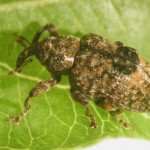The plum curculioIt was another slow start for the plum curculio (PC) this season with few egg laying scars 7 days out from 80% petal fall of McIntosh on May 14th at the HVRL. On the 21st of May we observed 5% PC injury to untreated Ginger Gold. Egg laying has increased dramatically after the 1st cover in the mid-Hudson Valley, likely due to increasing warmer temperatures. During our scouting of untreated trees on May 29th we’ve seen an increase of PC injury, now at 38% damaged fruitlets. During the thinning period between PF & 1st Cover, thinning rates of carbaryl have have also contributed to some reduce fruit injury by PC.
Be Alert: Recent hail events may have produced fruit injury in the form of fruitlet cuts that look nearly identical to PC feeding and egg laying scars. You will need to discern between the two types of damage to make clear management decisions. In assessing PC oviposition scars this time of year you will find a single egg tucked beneath the flap of the crescent cut.

We presently have 206 accumulated degree-days (base 50°F) using the petal fall date of May 14th for McIntosh through May 28th in Highland, NY using the NEWA model. Effective insecticide residual should be maintained until 308 degree days have accumulated from your petal fall date of McIntosh. Using predicted temperatures over the next 5 days we expect to accumulate 99DD, bringing the forecast date for the 308DD completion of PC migration to June 3rd for the HVRL NEWA station.
We’ve accumulated 2.35″ of rainfall since PF on May 14th. Over the past 7-days we have had 0.17″. Applications for PC made one week ago (May 21st) using the best materials at highest labeled rates will take you through to the 4th of June only by the skin of your teeth and only if we have no additional rain events. However, consider an insecticide application to pick up the last of the PC along with Codling Moth (CM) if we have rain or your material choice of a pyrethroid alone at moderate rates were applied. Applications of efficacious insecticides (such as high rates of the 5.25 lb./A rate of Imidan) out 14 days or less by the 3rd of June will likely have enough residue to kill the last of the PC migrating into orchards over the next 5 days.

Scouting along the orchard / woodland edge during this interval is highly recommended.
The neonicotinoid Actara (Thiamethoxam) should be used for plum curculio only as it will not provide control of codling moth. The OP Imidan 70WP®, WSP® (Phosmet), Avaunt 30WDG (Indoxacarb), Exirel (Cyantraniliprole), carbamate; Sevin® (carbaryl), and pyrethroids Danitol 2.4EC® (fenpropathrin), Asana XL® (esfenvalerate), Baythroid XL 1E®, 2EC® (beta-cyfluthrin), Lambda-Cy 1CS® (lambda-cyhalothrin), Warrior 1CS® (lambda-cyhalothrin), Proaxis 0.5CS®, and pre-mix formulations Besiege (chlorantraniliprole and lambda-cyhalothrin) Endigo ZC® (lambda-cyhalothrin / thiamethoxam), Leverage 360® (imidacloprid / beta-cyfluthrin), Gladiator® (zeta-cypermethrin / avermectin), Minecto Pro (chlorantraniliprol /Abamectin) Voliam Express® (lambda-cyhalothrin / thiamethoxam), Voliam Flexi® (chlorantraniliprol / thiamethoxam), should provide good-excellent control of both plum curculio and codling moth.
Be cautious: Pyrethroids may be weaker against the codling moth, especially under warmer conditions as the insect can increasingly metabolize and detoxify the pyrethroid chemistry at temperatures above 70F..


